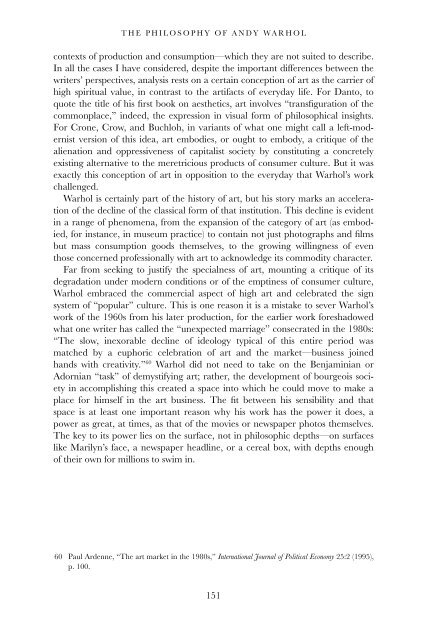Art in its Time: Theories and Practices of Modern Aesthetics
Art in its Time: Theories and Practices of Modern Aesthetics
Art in its Time: Theories and Practices of Modern Aesthetics
You also want an ePaper? Increase the reach of your titles
YUMPU automatically turns print PDFs into web optimized ePapers that Google loves.
THE PHILOSOPHY OF ANDY WARHOL<br />
contexts <strong>of</strong> production <strong>and</strong> consumption—which they are not suited to describe.<br />
In all the cases I have considered, despite the important differences between the<br />
writers’ perspectives, analysis rests on a certa<strong>in</strong> conception <strong>of</strong> art as the carrier <strong>of</strong><br />
high spiritual value, <strong>in</strong> contrast to the artifacts <strong>of</strong> everyday life. For Danto, to<br />
quote the title <strong>of</strong> his first book on aesthetics, art <strong>in</strong>volves “transfiguration <strong>of</strong> the<br />
commonplace,” <strong>in</strong>deed, the expression <strong>in</strong> visual form <strong>of</strong> philosophical <strong>in</strong>sights.<br />
For Crone, Crow, <strong>and</strong> Buchloh, <strong>in</strong> variants <strong>of</strong> what one might call a left-modernist<br />
version <strong>of</strong> this idea, art embodies, or ought to embody, a critique <strong>of</strong> the<br />
alienation <strong>and</strong> oppressiveness <strong>of</strong> capitalist society by constitut<strong>in</strong>g a concretely<br />
exist<strong>in</strong>g alternative to the meretricious products <strong>of</strong> consumer culture. But it was<br />
exactly this conception <strong>of</strong> art <strong>in</strong> opposition to the everyday that Warhol’s work<br />
challenged.<br />
Warhol is certa<strong>in</strong>ly part <strong>of</strong> the history <strong>of</strong> art, but his story marks an acceleration<br />
<strong>of</strong> the decl<strong>in</strong>e <strong>of</strong> the classical form <strong>of</strong> that <strong>in</strong>stitution. This decl<strong>in</strong>e is evident<br />
<strong>in</strong> a range <strong>of</strong> phenomena, from the expansion <strong>of</strong> the category <strong>of</strong> art (as embodied,<br />
for <strong>in</strong>stance, <strong>in</strong> museum practice) to conta<strong>in</strong> not just photographs <strong>and</strong> films<br />
but mass consumption goods themselves, to the grow<strong>in</strong>g will<strong>in</strong>gness <strong>of</strong> even<br />
those concerned pr<strong>of</strong>essionally with art to acknowledge <strong>its</strong> commodity character.<br />
Far from seek<strong>in</strong>g to justify the specialness <strong>of</strong> art, mount<strong>in</strong>g a critique <strong>of</strong> <strong>its</strong><br />
degradation under modern conditions or <strong>of</strong> the empt<strong>in</strong>ess <strong>of</strong> consumer culture,<br />
Warhol embraced the commercial aspect <strong>of</strong> high art <strong>and</strong> celebrated the sign<br />
system <strong>of</strong> “popular” culture. This is one reason it is a mistake to sever Warhol’s<br />
work <strong>of</strong> the 1960s from his later production, for the earlier work foreshadowed<br />
what one writer has called the “unexpected marriage” consecrated <strong>in</strong> the 1980s:<br />
“The slow, <strong>in</strong>exorable decl<strong>in</strong>e <strong>of</strong> ideology typical <strong>of</strong> this entire period was<br />
matched by a euphoric celebration <strong>of</strong> art <strong>and</strong> the market—bus<strong>in</strong>ess jo<strong>in</strong>ed<br />
h<strong>and</strong>s with creativity.” 60 Warhol did not need to take on the Benjam<strong>in</strong>ian or<br />
Adornian “task” <strong>of</strong> demystify<strong>in</strong>g art; rather, the development <strong>of</strong> bourgeois society<br />
<strong>in</strong> accomplish<strong>in</strong>g this created a space <strong>in</strong>to which he could move to make a<br />
place for himself <strong>in</strong> the art bus<strong>in</strong>ess. The fit between his sensibility <strong>and</strong> that<br />
space is at least one important reason why his work has the power it does, a<br />
power as great, at times, as that <strong>of</strong> the movies or newspaper photos themselves.<br />
The key to <strong>its</strong> power lies on the surface, not <strong>in</strong> philosophic depths—on surfaces<br />
like Marilyn’s face, a newspaper headl<strong>in</strong>e, or a cereal box, with depths enough<br />
<strong>of</strong> their own for millions to swim <strong>in</strong>.<br />
60 Paul Ardenne, “The art market <strong>in</strong> the 1980s,” International Journal <strong>of</strong> Political Economy 25:2 (1995),<br />
p. 100.<br />
151
















